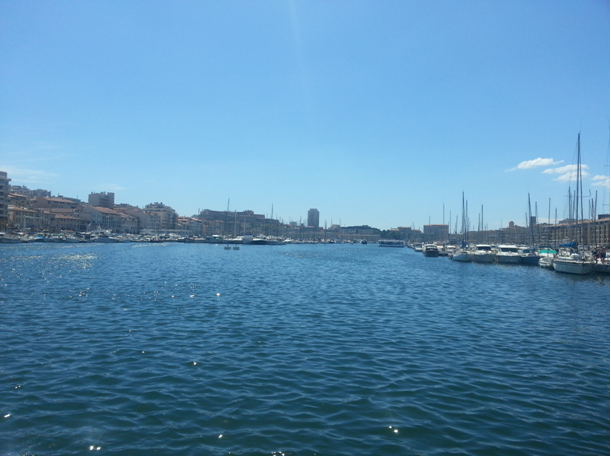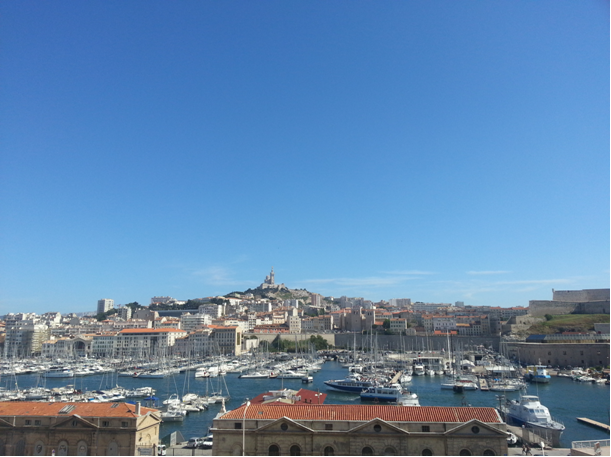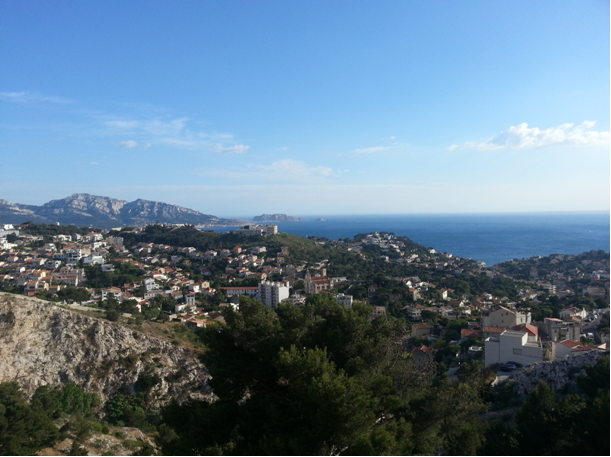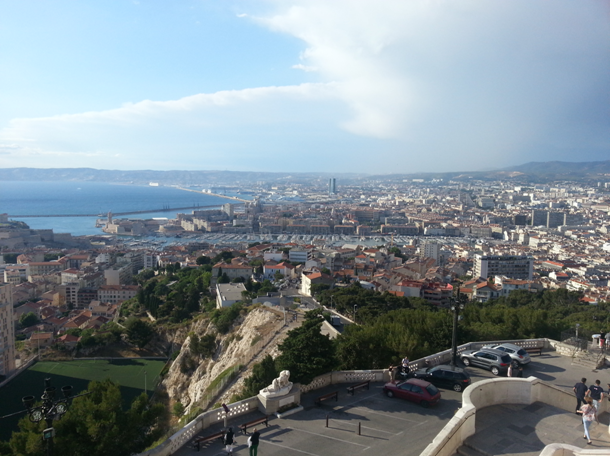Fri May 30 马赛Marseille
住宿:Fri May 30 - Sun Jun 1, ibis Marseille Gare Saint Charles, 1 Square Narvick, Marseille, 13001, France, +33491956209 (€ 194 for 2 nights)
早上沿尼斯海滨大道跑步,再一次享受尼斯的阳光,再找个能够看海的咖啡店坐下来(Le Balthazar, 3 Promenade des Anglais, Nice, 8.3€),cappuccino香浓,海面温柔,天空湛蓝,云淡风清,感觉似乎可以融化其中。舒服的阳光照在身上,我们再次感慨这里的美丽,是可以平和地欣赏和接受的,宁静不张扬,这就是尼斯的魅力,还没有离开, 已经想再回来。

乘火车前往马赛 (单程 NICE VILLE-》 MARSEILLE ST CHAR 每人37 €), 沿途景色迷人,2个半小车程的前一小时是沿着海岸的。驶过嘎纳不久便发现在蔚蓝海岸的一些海边,原来也是有细沙滩的。再过一两站,是山依海,海环山的美景,有时峭壁直入大海。这里的海边也是风情万种呀。


酒店就在火车站旁,到了马赛, 在火车站买好第二天去Aix的车票 (单程 MARCEILLE ST CHAR-》 AIX EN PROVENCE 每人7.8 €,回程价格相同), 而且有去飞机场的直达Bus也很方便(三人22€)。火车站附近的建筑很漂亮。

早就听说马赛是个不太像法国的城市, 眼见为实了。街道没有那么的干净整洁, 城市里面移民聚居区尤甚,但它是欧洲最古老的城市之一,自古以来就是地中海沿岸的经济和文化中心,有欧洲文化之都的美称,古迹很多。我们整整走了一天, 收获不小。
马赛旧港Old Port, 港口附近很热闹, 餐馆林立, 我们选了一家经济实惠的餐馆, 味道还不错 (La Chope D'or, 32 Quai Du Port 13002 Marseille, 48.5€)。

从旧港远眺Notre Dame- 马赛圣母院

老城区Le Panier,值得一提的是Le Panier的游览十分方便, 只要沿着地上不同颜色(粉色或红色)的标识线走, 可以走长线浏览所有古迹,也可以走短线挑重点。





马赛圣母院Basilique Notre Dame de la Garde,虽然不如巴黎圣母院的名气大, 但因为建在山顶,可以俯瞰马赛全城, 景色壮观。从马赛旧港远望教堂似乎很遥远, 于是决定乘bus上山, 参观完毕,我们步行下山, 只用了20分钟, 原来直线距离并不远。



马赛,是此行最后一个临海的城市。明天的Aix 就算内陆了。相比于温柔内敛的Nice,古典婉约的Antibes,平和恬静的Menton,张扬奔放的Cannes,穷奢极欲的Monaco, 马赛只能说是特立独行了。这个法国大革命的发源地,一半是海水,一半是火焰, 它的嘈杂中,透着勃勃生机。。。
Tips:
Le Panier, a stroll through the old Marseille: Marseilles has generously painted a red line marking the tourist route through the Panier.
Built on the site of the ancient Greek Massalia, the Panier is a typically Mediterranean district with colour-washed facades. The historic refuge of seafarers and generations of immigrants, the Panier is a peaceful haven, still working-class.
History of a district
The Panier became a working-class district when the Marseille middle-class decided to move out in the 17th century to relocate in the new districts designed by Colbert to the east. In the 19th century, as the commercial and industrial revolution got under way, it progressively acquired its bad reputation. Seen as an 'overpopulated hill with ill-repaired houses' by the town councillors, the Panier was considered an obstacle to the development and modernisation of the city. This excessively shady reputation did not prevent the village from developing its own way of life with a population living largely from the sea – fishermen, seafarers, amateur sailors.
Set on high ground (you 'go up to the Panier'), it attracted Neapolitans at the end of the 19th century, then Corsicans after the First World War. Part of the district was dynamited by the Germans in February 1943, except for the prestigious buildings. But the locals showed their mettle: even the smallest of plots sufficed to rebuild their high houses. Today, umpteen countries – from the Maghreb to the Comoro Islands without forgetting Vietnam – add their touch of colour to the Panier's cultural mosaic. Sitting on chairs, elders continue to chat in the sun while unruly kids call one another avé the accent so typical of Marseille...
Stroll through the Panier
Compact, the Panier can be crossed on foot, haphazardly, in search of fragrances and sensations, without fear of going astray. It is no longer the dangerous back alley where the otherwise courageous Marseillais dared not venture! The ancient Massalia has indeed been under constant rehabilitation for the past twenty years. Now ochre roughcast facades are brightening the area up and craftsmen, potters and santon makers are setting up here again. Writers of Marseille detective stories - Del Pappas et Carrese, inter alia – make it the setting of their adventures...
To reach the hill, do as the Greeks from Phocea did who arrived here 2600 years ago: start from the quayside in front of the city hall. Of Baroque inspiration, this small building recalls certain palaces on the Italian coast, like in Genoa. This work by Gaspard Puget and Mathieu Portal is built in a fine pink glowing stone from the quarry at La Couronne near Martigues (calcareous molasse already exploited by the Greeks). To the left of the city hall, you'll see one of the finest examples of reconstruction in Marseille: the blocks of flats by architect Pouillon, entirely clad with fine yellow stone from Vers-Pont-du-Gard. The architect, aware that the site had a several thousand years history, increased the number of classical elements: an attic storey covered with tiles, loggias and, at street level, arcades with a coffered ceiling.
Then take Rue de la Prison by the side of the city hall. You'll pass in front of a beautiful 16th century civilian palace, the Maison Diamantée with a facade featuring diamond facets. Rue de la Prison leads to Rue Caisserie, the Panier's oldest. Don't miss the wrought iron balcony of Hôtel Daviel, the former court of justice (1743), decorated with so-called marguerite panels, marguerites being the favourite motif of the local craftsmen in the 18th century. You can aslo admire the Hôtel-Dieu, a magnificent 18th century edifice renowned for its three floors of circular arcaded galleries.
Retrace your steps and start the 'ascension' of the Panier by the legendary Montée des Accoules which has earned the district its reputation as 'the village for goats' because it's so steep. The change in atmosphere is radical when you enter this steep Medieval alley with a guardrail down the centre. On the left, at number 5, stands the Panier's oldest building (17th century) with a rather dilapidated facade awaiting restoration.
On your right, Rue Poirier winds under the washing lines, like in Naples. Continue climbing and, at number 24, stop in front of André Robbe's Cabanon des Accoules. This maker of santons (of which the tradition arose in Marseille and not in Aubagne), campaigns for the development and safeguard of this district he knows inside out. Slightly further on, the Préau des Accoules is a former 18th century Jesuit college converted into an art centre for children.
The Vieille Charité, Marseille's architectural gem
Continue towards Place de Lenche, a pretty sunny little square with a beautiful view over the glistening water of the Vieux-Port. It is located on the former Greek agora. In the minds of locals it also conjures up images of gangster shootouts. Then follow Rue de l'Évêché to Place des Treize Cantons from where you can see the enormous Neo-Byzantine dome of the Nouvelle Major Cathedral. This square is the setting of legendary venues of local life, such as the famous Bar des Treize Coins, and the non-less famous Chocolatière du Panier, a minute black shop to which Casanova paid a visit. From here, walk up Rue du Panier for 100 metres.
Between Rues Rodillat and Pistoles you'll see the Vieille Charité, Marseille's architectural gem. Built between 1671 and 1749 to care for the city's down-and-outs, this former hospice is the work of the Puget brothers. Admire the chapel and its ovoid dome, a masterpiece of Italian Baroque. The place, a haven of peace and silence, groups many museums (Mediterranean archeology museum; African, Oceaninan, and Amerindian arts museum (MAAOA); François-Reichenbach collection).
Return to Place de Lorette, go down Rue de Lorette in the middle of which you'll cross the steep passageway bearing the same name. The contrast is brutal. Exit the Mediterranean village with narrow streets in mid-air; enter the Hausmannian city with the large and noisy artery, Rue de la République, leading to the Vieux-Port.




